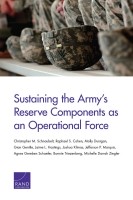| 来源类型 | Research Reports
|
| 规范类型 | 报告
|
| DOI | https://doi.org/10.7249/RR1495
|
| ISBN | 9780833096364
|
| 来源ID | RR-1495-A
|
| Sustaining the Army's Reserve Components as an Operational Force |
| Christopher M. Schnaubelt; Raphael S. Cohen; Molly Dunigan; Gian Gentile; Jaime L. Hastings; Joshua Klimas; Jefferson P. Marquis; Agnes Gereben Schaefer; Bonnie L. Triezenberg; Michelle D. Ziegler
|
| 发表日期 | 2017
|
| 出版年 | 2017
|
| 页码 | 222
|
| 语种 | 英语
|
| 结论 |
The Transformation of the RCs During the Iraq and Afghanistan Wars Provides Several Valuable Lessons- The RCs became an operational force before they were labeled as such.
- Two types of policies emerged to support RC use as an operational force — protecting from overuse and increasing readiness.
- The Iraq and Afghanistan wars reshaped the way the RCs were trained and equipped and also promoted an expeditionary mind set within the RCs.
- The increased reliance on the RCs was largely due to demand rather than their improved readiness.
- The RCs' readiness improved during the Iraq and Afghanistan wars.
- The RCs' readiness benefited from forewarning, fewer logistical constraints, and relatively less complex missions.
- Sustaining readiness post–Iraq and Afghanistan wars is only partially a policy question: it is also largely a resource issue.
|
| 摘要 |
- If the United States wants to sustain the RCs' readiness, it needs to continue operational employment of the RCs.
- Because cyclical readiness may not be the best approach in a period of diminished resources, the Army should consider whether the RCs should continue to use Army Force Generation (or its follow-on) versus return to a tiered readiness model.
- Although the policy was well intentioned and well received at the time, the Army should consider requesting that DoD amend the current policy that caps mobilization periods to one year, especially if most RC soldiers have volunteered for deployment.
- Although successful in allowing RC units to deploy more quickly after mobilization for OEF and OIF, the Army should reconsider the RCs' emphasis on premobilization training. Going forward, if there is more uncertainty about future operations, such a premobilization focus may no longer be a viable option.
- If the Army wants to continue to emphasize premobilization training, then it is essential for RC units to have the right equipment at home station and regional training centers to make the most out of training.
- The RCs should fully embrace roles as nonstandard force package providers rather than insisting on only deploying standard Modified Table of Organization and Equipment units such as full Brigade Combat Teams.
- The Army should reexamine its medical readiness program for the RC and the return on investment in terms of readiness gained from specific forms of medical care.
|
| 主题 | Military Education and Training
; Military Force Deployment
; Military Reserves
; Operational Readiness
; United States Army
|
| URL | https://www.rand.org/pubs/research_reports/RR1495.html
|
| 来源智库 | RAND Corporation (United States)
|
| 引用统计 |
|
| 资源类型 | 智库出版物
|
| 条目标识符 | http://119.78.100.153/handle/2XGU8XDN/108523
|
推荐引用方式
GB/T 7714 |
Christopher M. Schnaubelt,Raphael S. Cohen,Molly Dunigan,et al. Sustaining the Army's Reserve Components as an Operational Force. 2017.
|
|
文件名:
|
x1497275216031.jpg
|
|
格式:
|
JPEG
|

|
文件名:
|
RAND_RR1495.pdf
|
|
格式:
|
Adobe PDF
|
除非特别说明,本系统中所有内容都受版权保护,并保留所有权利。